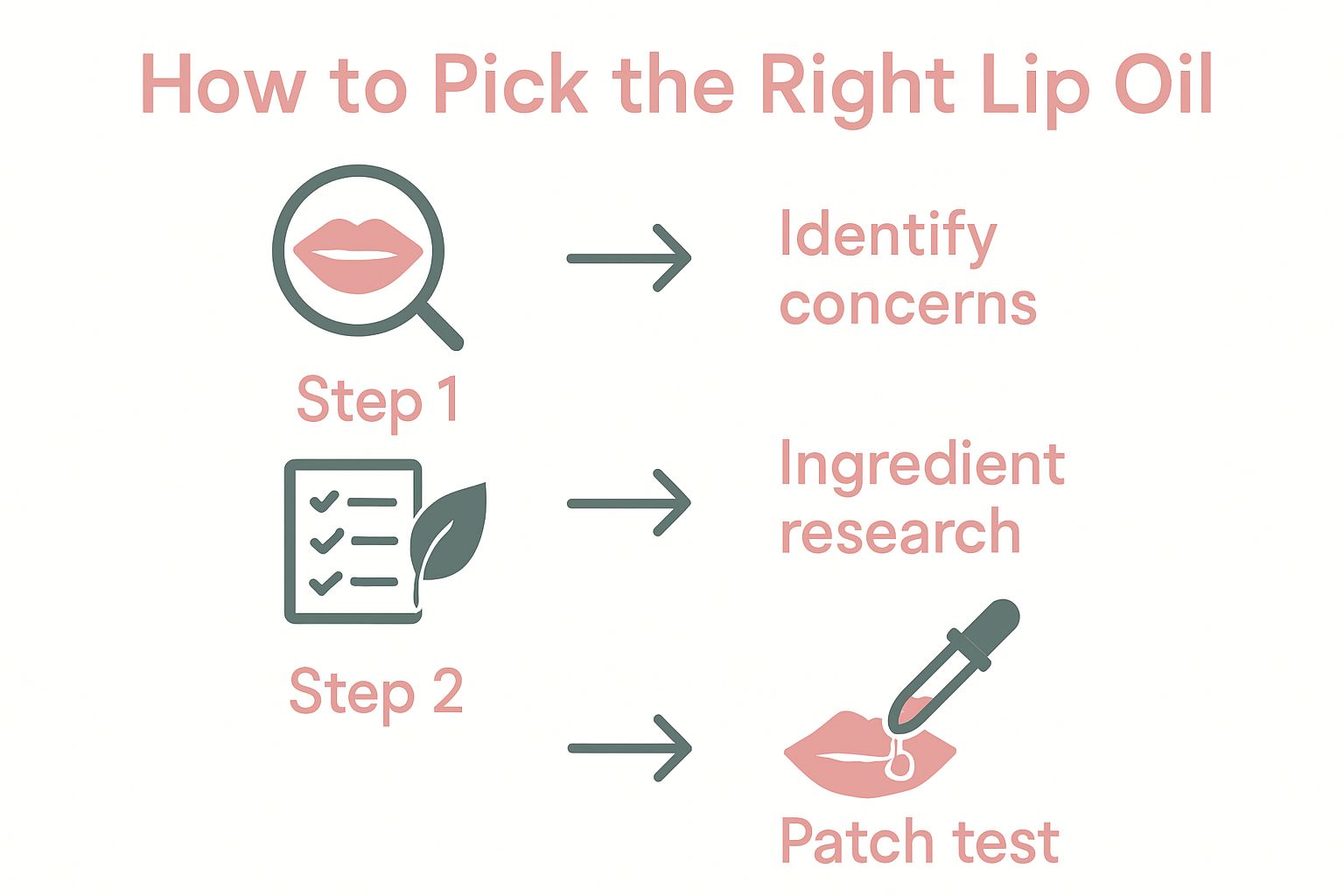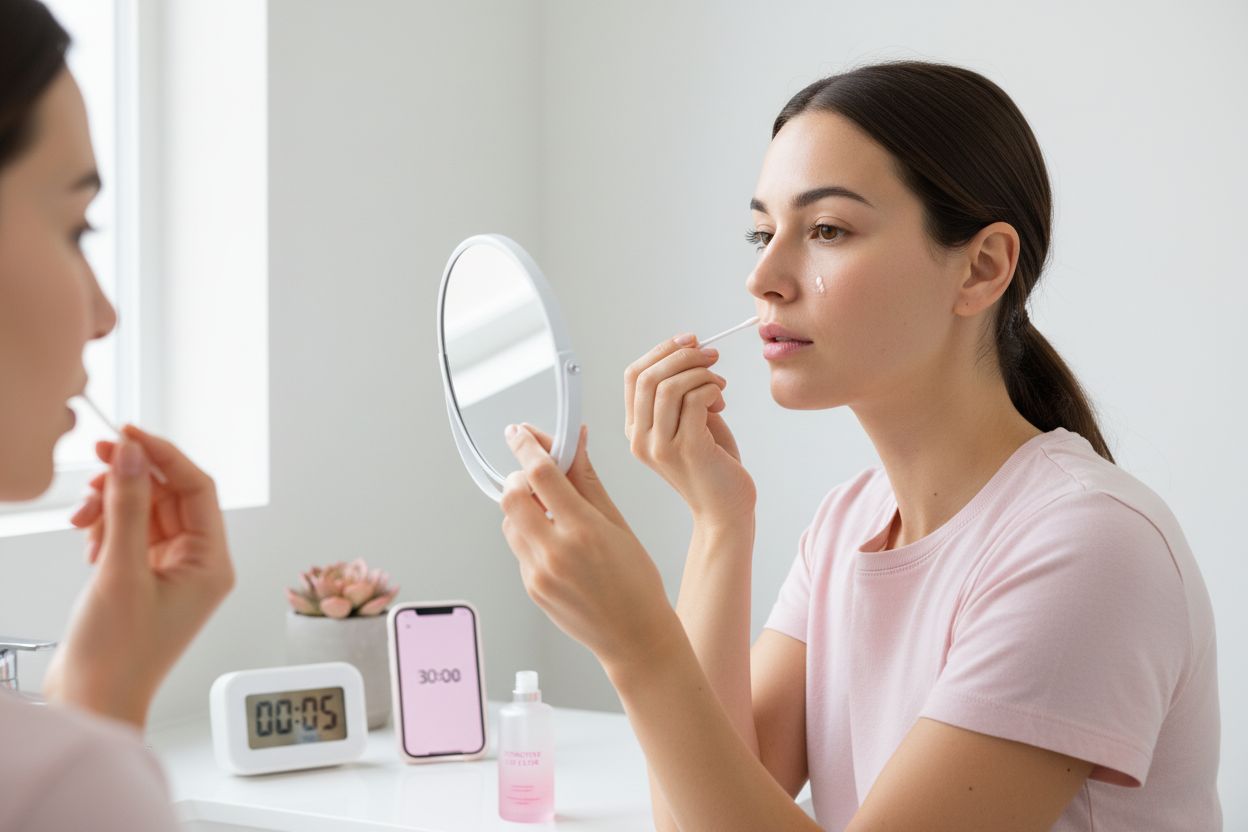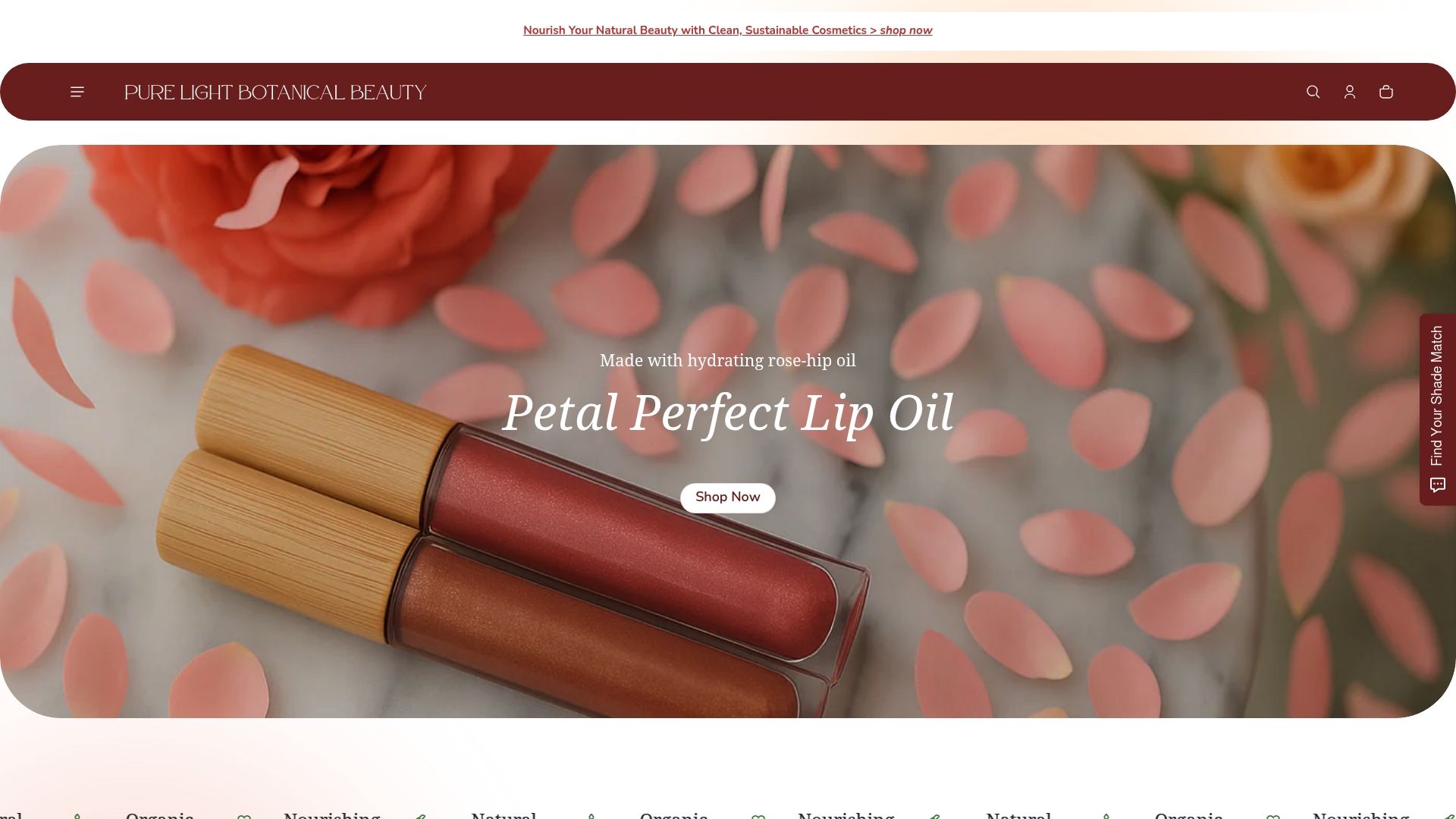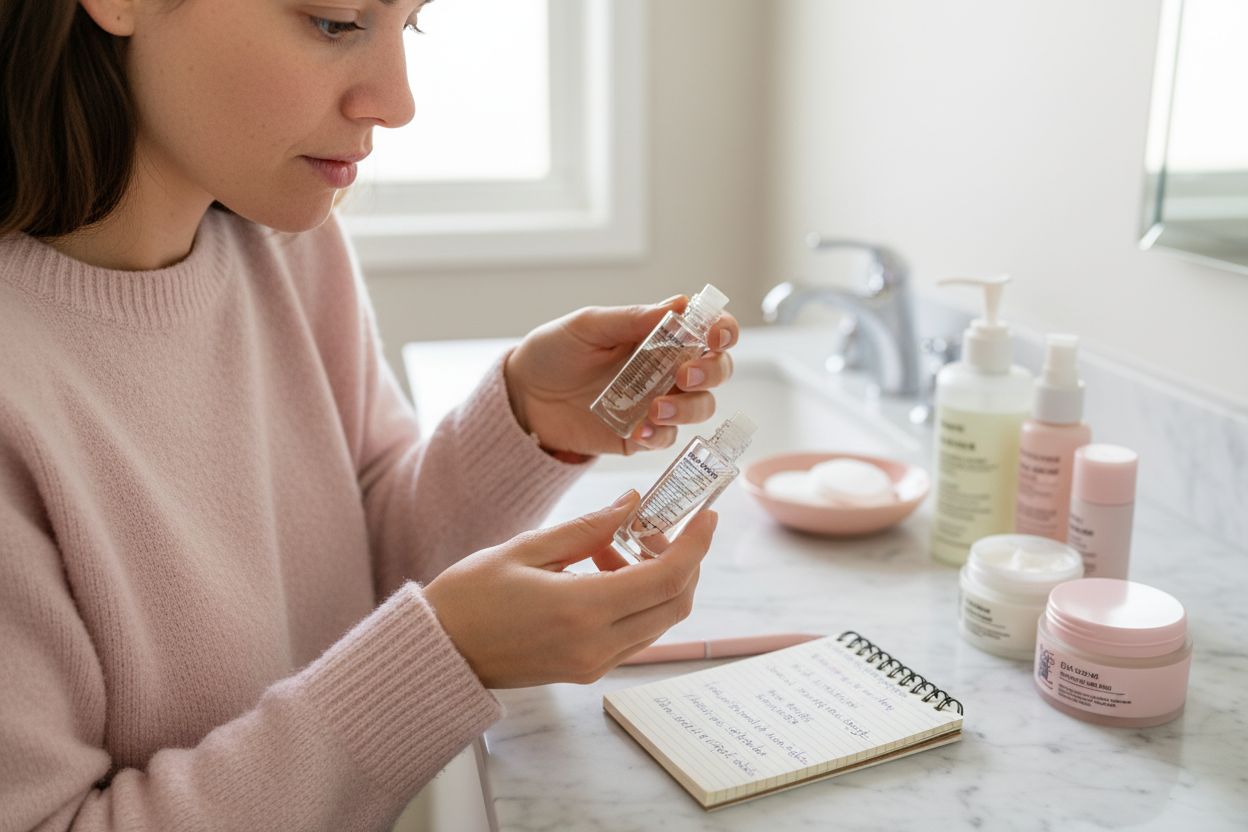Sensitive lips react to almost anything, from a change in the weather to the wrong ingredient in your favorite balm. Surprisingly, natural products can still be a problem for sensitive skin—just because it’s natural doesn’t make it safe. This means picking the right lip oil takes more than grabbing something labeled ‘botanical’ and hoping for the best.
Table of Contents
- Step 1: Identify Your Skin Concerns And Needs
- Step 2: Research Ingredients For Safe Options
- Step 3: Test The Product On A Small Area
- Step 4: Assess The Texture And Hydration Levels
- Step 5: Check For Product Reviews And Brand Transparency
Quick Summary
| Key Point | Explanation |
|---|---|
| 1. Identify your specific skin concerns | Conduct a personal assessment to understand your unique skin sensitivities, including irritation and allergic reactions. |
| 2. Research safe, healing ingredients | Look for non-irritating botanical oils and avoid synthetic fragrances or essential oils known to cause reactions. |
| 3. Perform a patch test first | Apply the lip oil to a small area and observe for 24 to 48 hours for any signs of irritation before full application. |
| 4. Assess texture and hydration | Choose lip oils that glide smoothly and provide lasting hydration without greasiness, ensuring they nourish your lips. |
| 5. Read detailed product reviews | Look for feedback from users with similar skin types and conditions to gauge efficacy and brand transparency. |
Step 1: Identify Your Skin Concerns and Needs
Before diving into how to pick the right lip oil for sensitive skin, understanding your unique skin landscape is crucial. Every skin tells a story, and sensitive skin speaks volumes about its needs through subtle signals that demand careful attention. Your journey begins with honest self-observation and recognizing the specific sensitivities that make your skin unique.
Mapping Your Skin’s Sensitivity Profile
Sensitive skin isn’t a one-size-fits-all condition. Some individuals experience redness and inflammation, while others encounter burning sensations, dryness, or immediate reactivity to new products. Start by examining your lip area closely. Do you notice persistent chapping? Frequent peeling? Unexpected allergic reactions? These are critical indicators that will guide your lip oil selection process.
To effectively assess your skin’s needs, spend a few days conducting a personal skin audit. Track how your lips respond to different environmental conditions, stress levels, and current skincare products. Note any patterns of irritation, such as reactions after using certain lip balms or experiencing more dryness during specific seasons. Temperature changes, wind exposure, and humidity levels can dramatically impact sensitive lip skin, making this observation period essential.
Consider scheduling a consultation with a dermatologist who specializes in sensitive skin conditions. They can provide professional insights into your specific sensitivities and potential underlying factors. Learn more about holistic approaches to sensitive skin relief that go beyond surface-level treatments.
Your skin sensitivity assessment should include a comprehensive review of:
- Allergic reaction history
- Current skincare product ingredients
- Frequency of lip irritation
- Environmental exposure triggers
- Underlying skin conditions like eczema or dermatitis
By understanding these nuanced details, you’re not just selecting a lip oil—you’re crafting a personalized skin healing strategy. The goal is finding a product that doesn’t merely mask symptoms but genuinely supports your lips’ delicate ecosystem, providing nourishment, protection, and genuine relief.
Step 2: Research Ingredients for Safe Options
Ingredient research transforms lip oil selection from a guessing game into a strategic healing journey for sensitive skin. Understanding the language of botanical ingredients becomes your protective shield against potential irritants and your pathway to genuine skin nourishment.
Decoding Safe Botanical Ingredients
Navigating the world of lip oil ingredients requires a detective’s keen eye and a healer’s intuition. Natural doesn’t automatically mean safe, especially for those with sensitive skin. Your mission is to become an ingredient investigator, parsing through complex labels and understanding which botanicals genuinely support your skin’s delicate balance.
Start by creating a personal watch list of ingredients that have historically triggered reactions. Common culprits include synthetic fragrances, menthol, camphor, and certain essential oils that can create intense sensations but often damage sensitive skin’s protective barrier. Look for lip oils rich in healing, non-reactive ingredients like jojoba oil, sunflower seed oil, and pure plant extracts that offer genuine nourishment without overwhelming your skin’s ecosystem.
Explore our comprehensive guide on botanical ingredients for sensitive skin relief to deepen your understanding of skin-loving botanicals. Pay special attention to ingredients that provide multi-dimensional healing: those that moisturize, protect, and support your skin’s natural regeneration processes.
Your ingredient research toolkit should include:
- Smartphone apps that scan and analyze ingredient lists
- Reputable dermatological websites explaining ingredient functions
- A personal journal tracking skin reactions and ingredient interactions
- Consultation resources with skincare professionals
Remember that ingredient research is an ongoing conversation with your skin. What works beautifully today might shift with changing environmental conditions, stress levels, or subtle hormonal variations. Approach this process with curiosity, patience, and a commitment to understanding your unique skin landscape. The right lip oil isn’t just a product—it’s a personalized healing companion crafted specifically for your skin’s narrative.
Step 3: Test the Product on a Small Area
Testing a new lip oil is like conducting a gentle, careful experiment with your skin’s unique ecosystem. This critical step transforms your product selection from theoretical research into a personalized, safe exploration of potential healing and nourishment.
The Patch Test: Your Skin’s Early Warning System
Before applying any new lip oil across your entire lips, create a controlled testing environment that respects your skin’s sensitivity. Choose a small, inconspicuous area near your lip line—typically the corner of your mouth—as your initial testing ground. This strategic location allows you to monitor potential reactions without compromising your entire lip area.
Apply a tiny, rice-grain sized amount of the lip oil and observe your skin’s response over 24 to 48 hours. Watch for subtle signals your skin might communicate: slight redness, tingling sensations, warmth, or any hint of discomfort. These are your body’s communication channels, providing immediate feedback about product compatibility.
 Do not rush this process. Sensitive skin requires patience and careful observation.
Do not rush this process. Sensitive skin requires patience and careful observation.
Discover more about creating a safe skincare testing protocol that protects and honors your skin’s unique needs. Timing matters significantly during this testing phase. Choose a moment when your skin isn’t already experiencing stress, such as during hormonal shifts, extreme weather changes, or after other skincare treatments that might influence your results.
Your comprehensive patch test checklist includes monitoring for:
- Immediate burning or stinging sensations
- Persistent redness or inflammation
- Unexpected texture changes
- Subtle allergic responses
- Increased skin sensitivity
If no adverse reactions occur within the 48-hour window, you can cautiously progress to applying the lip oil to a slightly larger area.
Use the following checklist table to track factors to observe during the patch test process. This helps ensure you spot any potential issues before committing to a new lip oil.
| Symptom to Monitor | What It Means | Recommended Action |
|---|---|---|
| Redness or inflammation | Potential irritation or mild allergic reaction | Stop use and consult dermatologist if persists |
| Tingling or burning | Incompatibility with sensitive skin | Remove product immediately, do not continue use |
| Unusual texture changes | Possible reaction to ingredients | Observe closely, discontinue if worsens |
| Delayed discomfort (24–48 hrs) | Slow-forming sensitivity or allergy | Avoid future use of tested product |
| No reaction | Good initial compatibility | Gradually increase area of application |
 Think of this as a gradual negotiation with your skin—building trust, understanding, and mutual respect. The right lip oil should feel like a gentle embrace, not a confrontational experience. Your skin’s comfort and healing are the ultimate indicators of a successful product match.
Think of this as a gradual negotiation with your skin—building trust, understanding, and mutual respect. The right lip oil should feel like a gentle embrace, not a confrontational experience. Your skin’s comfort and healing are the ultimate indicators of a successful product match.
Step 4: Assess the Texture and Hydration Levels
Texture and hydration are the silent languages of lip health, speaking volumes about a lip oil’s ability to truly nourish sensitive skin. This step transforms your selection process from a mere transaction into an intimate understanding of how a product will interact with your unique lip ecosystem.
Decoding Lip Oil Performance
Lip oils are not created equal, and for sensitive skin, the nuanced differences can mean the difference between healing and irritation. Begin by examining the oil’s initial sensation when applied. A perfect lip oil should feel like a whisper, gliding smoothly without overwhelming your delicate lip skin. Watch how the product moves—does it spread evenly? Does it absorb quickly or sit heavily on the surface? These subtle characteristics reveal crucial information about the oil’s compatibility with your skin.
Hydration isn’t just about momentary moisture; it’s about creating a sustainable environment of skin healing. Look for oils that provide a multi-layered approach to hydration—those that offer immediate relief while supporting long-term lip health. The right product should feel like it’s communicating with your skin, providing nourishment that goes beyond surface-level smoothness. Explore our comprehensive guide to understanding botanical hydration techniques to deepen your understanding of true skin nourishment.
Your comprehensive texture and hydration assessment should include tracking:
- Initial application smoothness
- Absorption rate
- Lasting moisture duration
- Skin comfort levels after application
- Absence of sticky or greasy residue
Pay attention to how your lips respond throughout the day. A high-quality lip oil for sensitive skin should provide consistent comfort, creating a protective barrier that shields against environmental stressors while simultaneously healing and supporting your lip’s natural moisture balance. Remember, the goal isn’t just temporary relief—it’s about creating a nurturing environment where your lips can truly thrive. Your patience in this assessment is an act of self-love, a careful dialogue between you and the product that will ultimately reveal the perfect lip oil for your unique skin story.
Step 5: Check for Product Reviews and Brand Transparency
Brand transparency is the cornerstone of trust in the sensitive skin beauty landscape. This step transforms your lip oil selection from a solitary decision into a community-informed journey, leveraging collective wisdom and shared experiences of individuals who understand the nuanced challenges of sensitive skin care.
Navigating the Landscape of Authentic Feedback
Real reviews are more than star ratings—they’re narratives of skin transformation. When examining product reviews, look beyond generic praise or criticism. Search for detailed accounts from individuals with similar skin sensitivities. Pay attention to reviewers who describe their specific skin conditions, the duration of product use, and the subtle changes they experienced. These personal stories offer insights that ingredient lists and marketing materials cannot capture.
Dig deeper than surface-level testimonials. Investigate the brand’s commitment to transparency by examining their ingredient sourcing, manufacturing processes, and ethical standards. Learn more about choosing clean beauty products that truly support sensitive skin and understand what makes a brand genuinely trustworthy.
Your comprehensive review investigation should include:
- Verified purchase reviews from multiple platforms
- Detailed accounts from individuals with sensitive skin
- Responses from the brand to customer feedback
- Consistency of positive experiences over time
- Specific mentions of skin healing and comfort
Remember that authentic transparency is characterized by vulnerability. Brands confident in their products will openly discuss potential limitations, share detailed ingredient information, and demonstrate a genuine commitment to customer well-being. Look for companies that provide scientific explanations, share research behind their formulations, and maintain an ongoing dialogue with their community. This approach transforms product selection from a transactional experience into a collaborative journey of skin healing and self-discovery. Your diligence in this step is an investment in finding not just a lip oil, but a skincare companion that truly understands and respects your skin’s unique story.
Transform Sensitive Lip Care Into a Ritual of Healing
If you’re feeling overwhelmed by irritation, dryness, or unpredictable reactions when searching for the right lip oil, you are not alone. Sensitive skin requires more than a generic solution. It needs gentle, restorative ingredients and a thoughtful approach to holistic healing. Our article walks you through how to identify your unique sensitivities, decode safe botanicals, and trust in both science and personal intuition when caring for your lips. Your next step takes you from research to real relief.
Below is a step overview table summarizing each key stage in picking the right lip oil for sensitive skin. Use this snapshot to guide your process from assessment to product selection.
| Step | Main Action | Key Outcome |
|---|---|---|
| 1 | Identify skin concerns | Understand personal sensitivities, triggers, and history of reactions |
| 2 | Research ingredients | Build a watch list of irritants and find nourishing botanical oils |
| 3 | Perform a patch test | Safely check for any negative reactions before full use |
| 4 | Assess texture and hydration | Choose lip oils that feel comfortable and provide lasting moisture |
| 5 | Review product and brand transparency | Select products supported by authentic reviews and open ingredient sourcing |

Imagine transforming your daily lip care into a nurturing ritual. Pure Light Botanical Beauty creates lip oils blended with clean, plant-based ingredients, designed specifically to soothe, protect, and heal delicate skin. Every lip oil celebrates your individuality and honors your story of sensitive skin by providing true hydration and comfort, never just surface-level solutions. Take control of your sensitive skin journey today. Explore Pure Light Botanical Beauty and curate a healing experience that empowers your lips to shine with confidence. Visit our holistic sensitive skin guide and get personalized product recommendations now.
Frequently Asked Questions
What should I consider when identifying my skin concerns for lip oil selection?
Before selecting a lip oil, conduct a personal skin audit to observe your lips for issues such as dryness, chapping, or allergic reactions. Pay attention to environmental triggers and consult a dermatologist if necessary.
How can I research ingredients to ensure I’m choosing a safe lip oil for sensitive skin?
Create a personal watch list of known irritants and seek out lip oils with calming, natural ingredients like jojoba oil and sunflower seed oil. Avoid products with synthetic fragrances, menthol, or camphor.
What is a patch test, and why is it important for sensitive skin?
A patch test involves applying a small amount of lip oil to an inconspicuous area near your lip line to monitor for adverse reactions before full application. This step is crucial to ensure the product is compatible with your sensitive skin.
How do I assess the texture and hydration levels of a lip oil?
Evaluate the lip oil upon application by noting its smoothness and absorption rate. A good lip oil should hydrate without leaving a sticky residue, providing long-lasting comfort and protection for sensitive lips.
Recommended
- Understanding the Reasons to Use Lip Oil for Sensitive Skin – Pure Light Botanical Beauty
- Step by Step Lip Care for Sensitive Skin Relief – Pure Light Botanical Beauty
- Understanding the Role of Healthy Lip Care for Sensitive Skin – Pure Light Botanical Beauty
- Understanding the Role of Plant Oils in Lips – Pure Light Botanical Beauty
